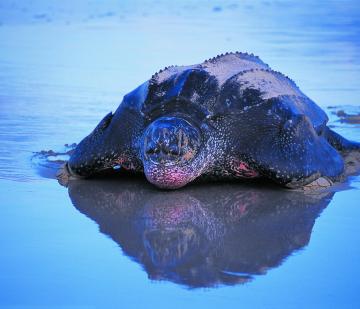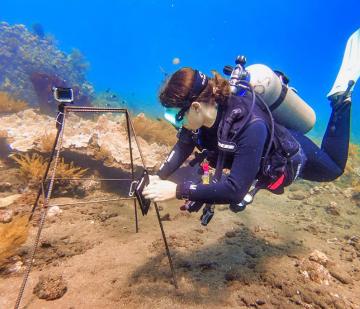BOOK WITH A $500 DEPOSIT
Sea of Giants: Marine Life of the Baja Peninsula







Join researchers on an exciting adventure on the Baja Peninsula as you study large marine animals, including dolphins, humpback whales, and whale sharks. Your findings will help scientists understand the effects of climatic events, urbanization, and a growing marine ecotourism industry on these remarkable marine ecosystems.
 The blue waters surrounding the Baja Peninsula are home to a rich diversity of marine life, most notably large marine animals, including dolphins, humpback whales, and whale sharks. But increasingly frequent extreme climatic events, such as marine heatwaves, disrupt the marine environment and threaten these critical species. Marine heatwaves can cause a variety of issues, including toxic algae blooms, disruptions in the food chain, and mass mortality events. However, little data has been collected on the exact impacts these events can have on large marine animals. Furthermore, urban sprawl and the area’s growing marine ecotourism industry threaten to amplify the impacts of these climatic events if not well managed.
The blue waters surrounding the Baja Peninsula are home to a rich diversity of marine life, most notably large marine animals, including dolphins, humpback whales, and whale sharks. But increasingly frequent extreme climatic events, such as marine heatwaves, disrupt the marine environment and threaten these critical species. Marine heatwaves can cause a variety of issues, including toxic algae blooms, disruptions in the food chain, and mass mortality events. However, little data has been collected on the exact impacts these events can have on large marine animals. Furthermore, urban sprawl and the area’s growing marine ecotourism industry threaten to amplify the impacts of these climatic events if not well managed.
You’ll visit two stunning locations on the Baja Peninsula, La Paz Bay and the adjacent Sea of Cortez and Punta Lobos, to help researchers discover how climatic events, urbanization, and marine ecotourism impact the marine environment. You’ll work alongside Dr. Lenin Oviedo to monitor the populations and behavior of bottlenose dolphins and humpback whales through boat and land-based surveys. Understanding these species' foraging activities, respiration rates, population sizes, and reproductive success can reveal how and to what extent the environment is disturbed.
You’ll also help investigate how closely tour operators adhere to current ecotourism regulations. You’ll join a whale shark tour operation and measure the boats’ proximity to whale shark aggregations, how whale sharks respond to the boat and tourists, and the water conditions. You may even have the opportunity to swim alongside whale sharks as you record their behavior and photograph the distinctive patterns around their dorsal fins to help identify individual sharks. The valuable data you collect will shed light on adherence to current regulations and the potential impact of these tours on whale shark behavior.
This project will provide researchers and policymakers with the baseline data needed to monitor the health of their coastal seascapes and develop management policies that ensure marine ecosystems remain healthy and sustainable for both wildlife and humans.
A Typical Itinerary
- DAY 1: Arrival, orientation
- DAY 2: Training on data collection techniques
- DAYS 3–4: Survey for dolphins, humpback whales, and whale sharks in La Paz Bay and the Sea of Cortez, alternate boat and land-based activities
- DAY 5: Day trip to Punta Lobos to survey humpback whales from land-based observation stations
- DAY 6: Survey for dolphins, humpback whales, and whale sharks in La Paz Bay and the Sea of Cortez, alternate boat and land-based activities
- DAY 7: Recreation day
- DAY 8: Final surveys, research wrap-up, possible museum tour
- DAY 9: Departure
Note: Depending on team size, participants may be split between survey sites on some days. The itinerary will be dependent on weather and research needs.
All teams will work with dolphins; however, the presence of whale sharks and humpback whales at these locations is seasonal. Whale sharks aggregate between late October and February, with the observation season highly regulated by local authorities and contingent upon the presence of sharks in the area. Humpback whales migrate to the area between January and April. These are general patterns and vary from season to season. Sightings of any animal are not guaranteed.
.
HOW YOU WILL HELP
.

Boat-based surveys
In a boat, you’ll follow bottlenose dolphins, humpback whales, and whale sharks to record their behavior and capture photos for individual identification.

Land station observations
Volunteers will hike to land-based stations to use binoculars to observe the movements of dolphins, humpback whales, and whale sharks. You will also help drone pilots log data and environmental conditions as they collect aerial videos of these target species.

Data Analysis
Volunteers will help map animal sightings and process the pictures and videos captured in the field.
Field conditions and research needs can lead to changes in the itinerary and activities. We appreciate your cooperation and understanding.
.
.
FEEDBACK & QUESTIONS
GET EARTHWATCH NEWSLETTER
Bi-weekly announcements, new expeditions, and updates on our impact around the globe.
.
.
.








